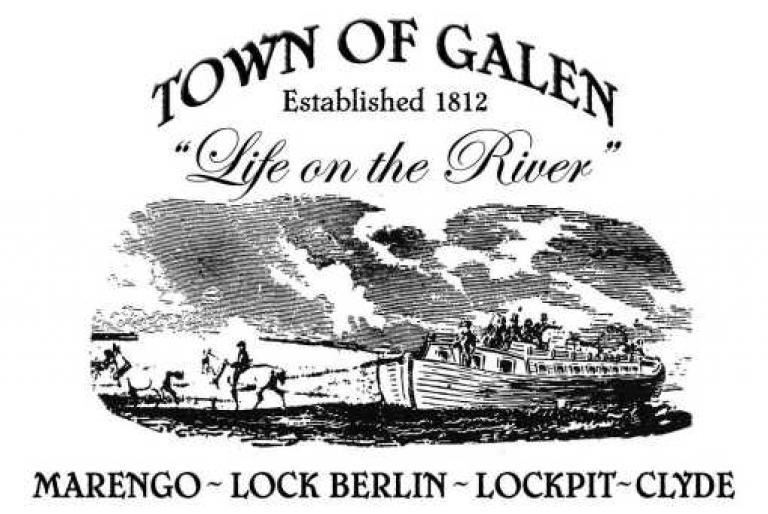If you find errors OR have additional information about this site, please send a message to contact@waynehistorians.org.
Town of Galen
| Historic Site #: | 03-000 (Exists) Type: K1 | Town: | Galen | ||
| Site Name: | Town of Galen | GPS Coordinates: | 43.083609, -76.870509 | ||
| Address: | 6 South Park Street Clyde New York | ||||
| Description: | |||||
| The Town of Galen was organized by a division of Junius, in Seneca County, February 14, 1812; on the 11th of April, 1823, it became a part of Wayne County. | |||||
 |
| Photo from Town of Galen Website |
| Historic narrative: | |||||
The first settlers coming to the Clyde area started arriving in 1800 as they traveled north from the more traveled east-west land route across the top of the Finger Lakes. Another route was the Clyde River which connected to other waterways that encouraged an easier form of transportation.
The Township of Galen was chartered in 1812 and included 57,000 acres. It was then the northern part of Seneca County. Galen was made part of Wayne County when the County was formed in 1823. The Village of Clyde, about 2 miles square in the middle of Galen, was incorporated in 1835. It is at the crossroads of the east-west Route 31 and the north-south Route 414. It is about 8 miles north of Exit 41 off the N.Y. State Thruway and about 12 miles south of Lake Ontario.
In years past, this was an agricultural area that included fruit growing and dairying along with vegetables and grain. Still having an agricultural base, the surrounding area farms now specialize in growing corn and soy beans. An exception comes with the purchase of farms over the last two decades by the Amish and Mennonite communities and the resulting diversity of entrepreneurial ventures that they create. These ventures include organic vegetables and nursery stock, baking, woodworking, shed-building, leather work and the raising of sheep and goats. There is also a productive farm machine manufacturer southwest of the Village.
Among prominent industries that have a history of a half century or more in Clyde, there is Parker-Hannifin, which recently agreed to join with General Electric to form Advanced Atomization Technologies. Also on the boundaries of the Village are Thomas Electronics of New York, DiSanto Jet Gas (propane), and Finger Lakes Construction.
The original spur to the growth of the area was the Erie Canal, which opened in 1825. It has seen improvements and some re-routing over the years, and by 1919 it used a deepened Clyde River. In the 1850's, following the logic of the Canal, the water level route was used by the newly constructed railroads and Clyde was an attractive stop. By 1870, the population of Galen, including Clyde, peaked at 5,706. By 2010, the population of the Town and the Village combined for a total of 4,181, almost evenly split between the two municipalities.
The Village warmly greeted the arrival of a Save-A-Lot grocery store in 2012, which ended a drought of three years without a major grocery store. Retail outlets have diminished in number over the years, but the Village is still benefited by the presence of the Clyde Hardware and two banking institutions among other storefronts. The Village includes four churches and a school district that merged with the neighboring school to the east to form the Clyde-Savannah School District in the 1960's. The K-12 enrollment is now under 900 students.
Visitors to the Village first note the Route 414 bridge over the Erie Canal. The bridge connects the north and south portions of the Village. The bridge also spans the CSX and Amtrak mainline. In order to board a train, however, it is necessary for one to travel to Syracuse or Rochester. Clyde is halfway between the two cities.
Like many small towns, Clyde has evolved over time but it retains a certain self reliance and energy which shows itself in neighbor reaching out to neighbor in times of need. It takes pride in its rural surroundings but also enjoys its proximity to centers of commerce and culture. | |||||
Town of Galen Website
Wikipedia - Town of Galen, NY
Wikipedia - Village of Clyde, NY
NYGenWeb - Town of Galen
Clyde-Savannah School District
